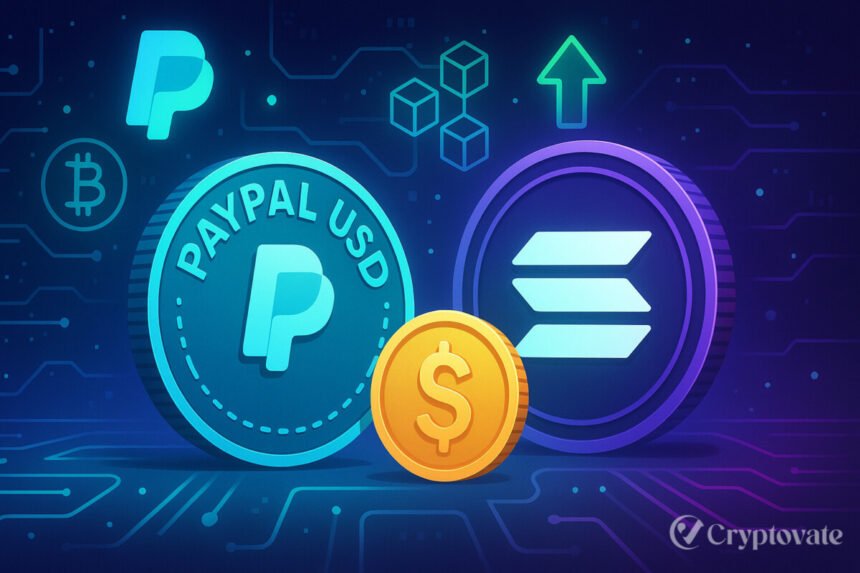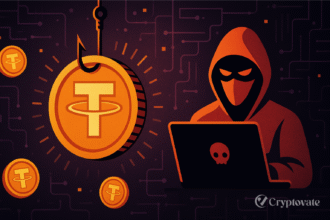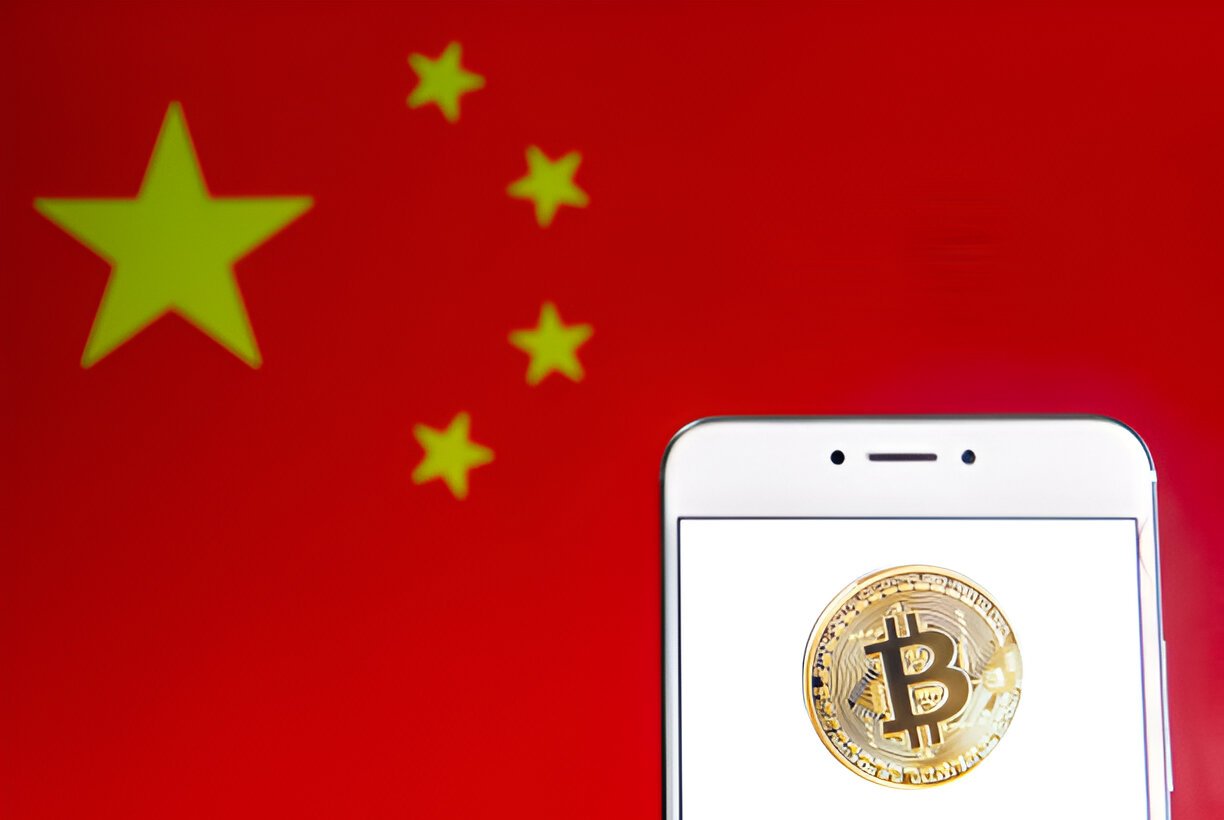– Ad –
| Getting your Trinity Audio player ready... |
PayPal’s PYUSD stablecoin foray into the cryptocurrency market has been marked by the introduction of its stablecoin, PayPal USD (PYUSD). Launched in August 2023 on the Ethereum blockchain, PYUSD was designed to offer a stable digital currency fully backed by the U.S. dollar. This stablecoin aims to bridge the gap between traditional finance and the digital currency world, providing users with a reliable and secure means of transacting in the fast-evolving crypto ecosystem.
Overview of PayPal’s PYUSD and Its Recent Growth
Since its inception, PYUSD has seen a steady increase in adoption, but its growth trajectory took a significant leap following its integration with the Solana blockchain in May 2024. Initially, PYUSD’s supply grew at a moderate pace on Ethereum, as users appreciated its stability and the backing of a reputable financial institution like PayPal. However, it was the strategic decision to expand PYUSD to Solana that truly ignited its growth. Within just a month of this integration, PYUSD’s supply surged by over $300 million, a 45% increase, bringing the total supply close to $820 million. This rapid expansion has positioned PYUSD as one of the fastest-growing stablecoins in the market, now ranking among the top six stablecoins globally.
Significance of Solana Integration
The integration of PYUSD with Solana has been a key factor in its recent success. Solana, known for its high-speed transactions and low fees, provided an ideal platform for PYUSD to scale quickly. The Solana blockchain’s robust infrastructure has attracted numerous decentralized finance (DeFi) protocols, which, in turn, have offered attractive incentives to users who deposit PYUSD. These incentives, including annual returns of nearly 20%, have made PYUSD an appealing option for both retail and institutional investors. The move to Solana not only enhanced PYUSD’s accessibility and usability but also solidified its position in the DeFi space, allowing it to compete effectively with other major stablecoins.
This strategic expansion has also led to a shift in PYUSD’s distribution, with the stablecoin’s balance on Solana now surpassing that on Ethereum. This demonstrates the growing importance of Solana as a blockchain network and highlights PayPal’s ability to adapt to market demands by leveraging cutting-edge technology to boost PYUSD’s growth and adoption.
PYUSD’s Supply Growth
In the last month, PayPal’s PYUSD stablecoin has experienced remarkable growth, with its supply increasing by more than $300 million. This 45% surge has elevated PYUSD’s total supply to nearly $820 million. The rapid growth of PYUSD is particularly noteworthy when compared to other stablecoins in the market, positioning it among the fastest-growing digital assets in this category.

This growth has been primarily fueled by the strategic integration of PYUSD with the Solana blockchain. Initially launched on Ethereum, PYUSD saw steady but modest growth. However, the expansion to Solana in May 2024 acted as a catalyst for accelerated adoption. Solana’s high-speed, low-cost transaction environment, combined with attractive incentives offered by decentralized finance (DeFi) platforms, has made PYUSD a preferred choice for many users.
When compared to other stablecoins like Tether (USDT) and USD Coin (USDC), PYUSD’s recent growth rate is impressive. While Tether and USD Coin continue to dominate the market in terms of total supply, PYUSD’s rapid ascent highlights its potential to become a major competitor, particularly as it gains more traction within the Solana ecosystem.
The expansion of PYUSD’s supply, driven by its integration with Solana, not only showcases the growing demand for stablecoins but also underscores the importance of blockchain technology in enhancing the scalability and adoption of digital currencies.
Impact of Solana Integration
The integration of PayPal’s PYUSD with the Solana blockchain has had a profound impact on the stablecoin’s growth and adoption. Originally launched on Ethereum, PYUSD experienced steady growth, but it was the strategic move to expand to Solana that truly accelerated its momentum. The decision to integrate with Solana was driven by the need to leverage the blockchain’s unique advantages, which have significantly contributed to PYUSD’s rapid rise.
Explanation of Solana’s Role in PYUSD’s Growth
Solana’s blockchain is renowned for its high-speed transactions and low fees, making it an attractive platform for digital assets like PYUSD. Unlike Ethereum, which can be burdened by higher transaction costs and slower processing times during periods of congestion, Solana offers a scalable solution that can handle a large number of transactions quickly and at a fraction of the cost. This scalability is crucial for stablecoins, which are often used in high-frequency trading and decentralized finance (DeFi) applications where speed and efficiency are paramount.
By integrating with Solana, PYUSD has been able to tap into a more efficient and cost-effective network, which has, in turn, boosted its appeal to both retail and institutional investors. The faster transaction speeds and lower costs associated with Solana have made PYUSD more accessible and practical for everyday use, whether for trading, payments, or other financial activities. This has resulted in a significant increase in the adoption of PYUSD, particularly within the Solana ecosystem, where users are increasingly looking for stablecoins that can be used seamlessly within various DeFi protocols.
Incentives for Users of Solana-Based DeFi Protocols
One of the most significant drivers of PYUSD’s growth on Solana has been the attractive incentives offered to users of Solana-based DeFi platforms. DeFi protocols on Solana, such as Kamino and Drift, have created compelling financial incentives for users to deposit PYUSD. These platforms offer yields as high as 20% annually for staking or providing liquidity with PYUSD, far outpacing traditional savings accounts and even many other crypto investments.
These high-yield opportunities have attracted a large number of investors and traders to PYUSD, as they seek to maximize their returns while still benefiting from the stability of a dollar-backed stablecoin. The appeal of earning substantial returns on a stable asset has led to a surge in demand for PYUSD, further boosting its supply on Solana. In fact, the balance of PYUSD on Solana has now surpassed that on Ethereum, highlighting the growing importance of Solana in the stablecoin’s distribution network.
However, it’s worth noting that while these high yields have driven rapid adoption, they have also raised concerns among some market observers. The high returns offered by Solana-based DeFi protocols are reminiscent of the incentives that were once offered by Terra’s UST, an algorithmic stablecoin that ultimately failed. However, unlike UST, PYUSD is fully backed by the U.S. dollar, providing a layer of security that mitigates the risks associated with high-yield investments.
Overall, the integration of PYUSD with Solana has not only enhanced the stablecoin’s scalability and efficiency but also positioned it as a key player in the DeFi space. The combination of Solana’s advanced blockchain technology and the lucrative incentives offered by its DeFi ecosystem has driven significant growth for PYUSD, setting it on a path to becoming one of the leading stablecoins in the market.
Market Observations
The rapid growth of PayPal’s PYUSD, especially following its integration with the Solana blockchain, has drawn significant attention in the cryptocurrency market. While the stablecoin’s success is evident in its rising supply and adoption, there are also growing concerns and skepticism, particularly regarding the sustainability of the high-yield incentives offered by Solana-based decentralized finance (DeFi) platforms.
Skepticism Regarding High-Yield Incentives
One of the key factors driving the adoption of PYUSD on Solana has been the attractive incentives offered by various DeFi protocols, such as Kamino and Drift. These platforms provide users with yields as high as 20% annually for depositing PYUSD, which is significantly higher than what traditional financial products offer. While these high yields have undoubtedly contributed to PYUSD’s rapid growth, they have also sparked concerns among market observers.
The skepticism primarily stems from the history of high-yield stablecoins in the cryptocurrency space, where similar incentives have often led to unsustainable growth and eventual collapse. High yields in DeFi are typically associated with increased risk, as they rely on continuous inflows of new capital to maintain the promised returns. If the inflows slow down or the market conditions change, these platforms may struggle to sustain the high returns, leading to a potential liquidity crisis or even collapse.
Market analysts point out that while PYUSD’s current success is tied to these attractive incentives, it’s crucial to consider the long-term sustainability of such high yields. The concern is that if the rewards were to decrease or disappear, it could lead to a significant drop in demand for PYUSD, especially among yield-seeking investors. This could, in turn, affect the stablecoin’s supply and overall stability.
Comparison to Terra’s UST Stablecoin and PYUSD’s Dollar Backing
The concerns surrounding PYUSD’s high yields are further amplified by comparisons to Terra’s UST, a once-popular algorithmic stablecoin that eventually failed spectacularly. Terra’s UST offered high yields through its Anchor Protocol, which promised returns of up to 20%. However, UST was an algorithmic stablecoin, meaning it wasn’t backed by traditional assets like the U.S. dollar. Instead, it relied on a complex mechanism involving the minting and burning of its sister token, LUNA, to maintain its peg to the dollar.
This model worked well during periods of high demand, but it was inherently fragile. When market confidence waned, and there was a rush to redeem UST for LUNA, the system couldn’t sustain the demand, leading to a massive devaluation of both tokens and a collapse of the entire ecosystem. The fall of UST sent shockwaves through the crypto market, leading to billions of dollars in losses and eroding trust in algorithmic stablecoins.
PYUSD, however, differs fundamentally from UST in that it is fully backed by the U.S. dollar. For every PYUSD token issued, there is an equivalent dollar held in reserve, ensuring that the stablecoin maintains its value and can be redeemed at any time. This dollar backing provides a level of security and stability that algorithmic stablecoins like UST could not offer.
The dollar backing of PYUSD mitigates the risk of a collapse similar to UST, as it does not rely on complex algorithms or market dynamics to maintain its peg. Instead, its value is directly tied to the U.S. dollar, providing users with confidence that their holdings are safe and can be redeemed for fiat currency. This makes PYUSD a more secure option for those looking to participate in DeFi activities on Solana without the inherent risks associated with algorithmic stablecoins.
In conclusion, while the high-yield incentives on Solana have been a significant driver of PYUSD’s growth, they also come with risks that market participants need to be aware of. However, PYUSD’s dollar backing provides a strong foundation that differentiates it from more speculative stablecoins like UST, offering users a safer and more reliable alternative in the volatile world of cryptocurrency.
Adoption and Exchange Support
The adoption and exchange support for PayPal’s PYUSD stablecoin have been pivotal in its rapid growth and increasing presence in the cryptocurrency market. Following its integration with the Solana blockchain, PYUSD has seen significant shifts in its distribution across different networks, along with growing support from major cryptocurrency exchanges. These factors have played a crucial role in solidifying PYUSD’s position as a leading stablecoin.
PYUSD’s Balance on Solana vs. Ethereum
Initially launched on the Ethereum blockchain in August 2023, PYUSD experienced moderate growth as it benefited from Ethereum’s extensive ecosystem and established user base. However, the expansion to Solana in May 2024 marked a turning point in PYUSD’s trajectory. The integration with Solana introduced PYUSD to a blockchain known for its high transaction speeds and low fees, which are critical factors for widespread adoption, particularly in the decentralized finance (DeFi) space.
As a result of this strategic move, PYUSD’s balance on Solana has now surpassed its balance on Ethereum. According to data from DeFiLlama, the supply of PYUSD on Solana exceeds $462 million, while its balance on Ethereum stands at around $366 million. This shift underscores the growing importance of Solana as a preferred network for PYUSD, driven by the blockchain’s superior scalability and efficiency.
The rapid increase in PYUSD’s balance on Solana can be attributed to the attractive yields offered by Solana-based DeFi platforms, which have drawn a significant amount of liquidity into the stablecoin. Users are increasingly favoring Solana for transactions involving PYUSD, as the network’s low fees make it a more cost-effective option compared to Ethereum, where gas fees can be prohibitively high during periods of network congestion.
This trend highlights a broader shift in the stablecoin market, where newer blockchains like Solana are gaining traction as alternatives to Ethereum, particularly for use cases that require high throughput and low costs. PYUSD’s success on Solana demonstrates how the choice of blockchain can significantly influence the adoption and distribution of a stablecoin, with users gravitating towards networks that offer better performance and financial incentives.
Increased Adoption by Exchanges, Particularly Bybit
The growing adoption of PYUSD has not gone unnoticed by major cryptocurrency exchanges, which have increasingly started to support the stablecoin across various networks. Among these exchanges, Bybit stands out as a key player in facilitating the wider use of PYUSD, particularly on the Solana blockchain.
Bybit, one of the top three cryptocurrency exchanges globally, has recently added support for PYUSD deposits and withdrawals on the Solana network. This move is significant for several reasons. First, Bybit’s support provides PYUSD with access to a large and active user base, which is critical for the stablecoin’s liquidity and usability. Bybit has over 40 million users, with the platform adding 10 million new users in less than a month, reflecting its rapid growth and the increasing demand for digital assets like PYUSD.
The addition of PYUSD on Solana by a major exchange like Bybit also signals growing confidence in the stablecoin’s long-term viability and its role within the broader cryptocurrency ecosystem. By enabling PYUSD transactions on Solana, Bybit is facilitating faster and cheaper transfers for its users, making the stablecoin more attractive for trading, payments, and DeFi activities.
Moreover, the support from Bybit and other exchanges enhances the accessibility of PYUSD, allowing users to easily move their assets between different platforms and blockchains. This interoperability is crucial for the stablecoin’s adoption, as it ensures that users can leverage PYUSD across various applications, whether for trading on exchanges, earning yields in DeFi, or making payments in the real world.
In conclusion, the adoption and exchange support for PYUSD, particularly the growing balance on Solana and the increased backing from exchanges like Bybit, have been instrumental in the stablecoin’s rapid rise. These developments highlight the importance of strategic blockchain integrations and strong exchange partnerships in driving the growth and widespread acceptance of digital currencies like PYUSD. As PYUSD continues to expand its presence across different networks and platforms, it is poised to become a dominant force in the stablecoin market, offering users a secure, efficient, and widely accepted digital asset.
Conclusion
The journey of PayPal’s PYUSD stablecoin from its initial launch on Ethereum to its rapid rise following integration with the Solana blockchain is a testament to the dynamic nature of the cryptocurrency market and the strategic decisions that drive success. PYUSD’s growth story is characterized by its ability to leverage the strengths of different blockchain networks, attract users with compelling incentives, and gain the trust of major cryptocurrency exchanges.
Strategic Expansion and Blockchain Integration
The integration of PYUSD with the Solana blockchain marked a pivotal moment in the stablecoin’s development. Solana’s high-speed transactions, low fees, and robust infrastructure provided PYUSD with a platform that could support rapid scaling and broader adoption. The decision to expand to Solana was not just a technical move; it was a strategic choice that enabled PYUSD to tap into a growing ecosystem of decentralized finance (DeFi) applications, where the need for efficient and cost-effective stablecoins is paramount.
This expansion was particularly successful due to Solana’s appeal to both retail and institutional investors who are increasingly looking for stablecoins that can be used across various DeFi protocols. The incentives offered by these platforms, such as high annual yields for staking PYUSD, attracted significant liquidity, further boosting the stablecoin’s supply and reinforcing its position in the market.
Adoption by Major Exchanges
Another key factor in PYUSD’s rise has been the support from major cryptocurrency exchanges like Bybit. Exchange support is crucial for any stablecoin, as it directly impacts liquidity, accessibility, and user adoption. Bybit’s decision to support PYUSD on the Solana network provided the stablecoin with a significant boost, giving it access to a large and growing user base. This move also enhanced PYUSD’s utility, enabling users to easily trade, transfer, and use the stablecoin across different platforms and blockchains.
The backing by exchanges like Bybit not only facilitated broader adoption but also signaled confidence in PYUSD’s long-term stability and security. This confidence is underpinned by PYUSD’s dollar backing, which distinguishes it from more speculative stablecoins and provides a layer of security that is crucial in the volatile world of cryptocurrencies.
The Role of Dollar Backing and Market Trust
Throughout its growth, PYUSD has maintained a strong foundation due to its full backing by the U.S. dollar. This dollar backing is a critical element that has helped PYUSD gain the trust of users and investors alike. Unlike algorithmic stablecoins, which rely on complex mechanisms to maintain their peg, PYUSD’s value is directly tied to the U.S. dollar, ensuring that it remains stable and secure even in times of market volatility.
This stability has been a key factor in PYUSD’s appeal, especially in a market that has seen the collapse of other high-profile stablecoins, such as Terra’s UST. The collapse of UST highlighted the risks associated with algorithmic stablecoins and reinforced the importance of having a stablecoin that is fully backed by traditional assets. PYUSD’s dollar backing provides users with confidence that their holdings are safe, redeemable, and protected against the risks that have plagued other projects.
Looking Ahead: PYUSD’s Future Prospects
As PYUSD continues to grow, its future prospects appear promising. The stablecoin is well-positioned to capitalize on the expanding DeFi market, especially on the Solana network, where its balance has already surpassed that on Ethereum. The ongoing support from exchanges, combined with the robust incentives offered by DeFi platforms, suggests that PYUSD will continue to attract new users and liquidity.
However, the future success of PYUSD will depend on its ability to maintain the trust of its users, manage the risks associated with high-yield incentives, and continue to innovate in a rapidly evolving market. As PayPal continues to navigate the complexities of the cryptocurrency space, PYUSD’s performance will be closely watched as a bellwether for the broader adoption of stablecoins in both retail and institutional contexts.
In conclusion, PYUSD’s rise is a clear example of how strategic blockchain integration, strong financial backing, and widespread exchange support can drive the success of a digital asset. As it approaches the $1 billion milestone, PYUSD is not just a stablecoin—it is a symbol of the growing convergence between traditional finance and the emerging world of decentralized digital currencies.
FAQs
What is PayPal’s PYUSD stablecoin?
PayPal USD (PYUSD) is a stablecoin launched by PayPal in August 2023. It is fully backed by the U.S. dollar, meaning that each PYUSD token is supported by an equivalent dollar in reserve, providing stability and reliability for users in the cryptocurrency market.
How has PYUSD grown since its launch?
Since its launch, PYUSD has seen significant growth, especially after its integration with the Solana blockchain in May 2024. The stablecoin’s supply has surged by over $300 million in a single month, bringing its total supply close to $820 million, making it one of the fastest-growing stablecoins in the market.
Why did PayPal integrate PYUSD with the Solana blockchain?
PayPal integrated PYUSD with the Solana blockchain to take advantage of Solana’s high-speed transactions and low fees. This move has enabled PYUSD to scale rapidly and become more accessible, particularly within the decentralized finance (DeFi) ecosystem, where users seek efficient and cost-effective stablecoins.
What are the risks associated with the high-yield incentives offered by Solana-based DeFi platforms for PYUSD?
The high-yield incentives offered by Solana-based DeFi platforms, which can be as high as 20% annually, come with risks. While they attract liquidity, there is skepticism about their sustainability, as they may rely on continuous inflows of new capital. If market conditions change, these platforms might struggle to maintain such high returns, potentially leading to decreased demand for PYUSD.
How does PYUSD compare to Terra’s UST stablecoin?
PYUSD differs fundamentally from Terra’s UST in that it is fully backed by the U.S. dollar. UST was an algorithmic stablecoin, which relied on complex mechanisms to maintain its value and eventually collapsed. In contrast, PYUSD’s dollar backing provides stability and reduces the risk of devaluation, offering a more secure option for users.
Which major exchanges support PYUSD, and why is this important?
Major exchanges like Bybit support PYUSD, particularly on the Solana network. This support is crucial as it enhances the stablecoin’s liquidity, accessibility, and adoption, allowing users to trade and use PYUSD across different platforms and blockchains, which is essential for its widespread acceptance and utility.
















